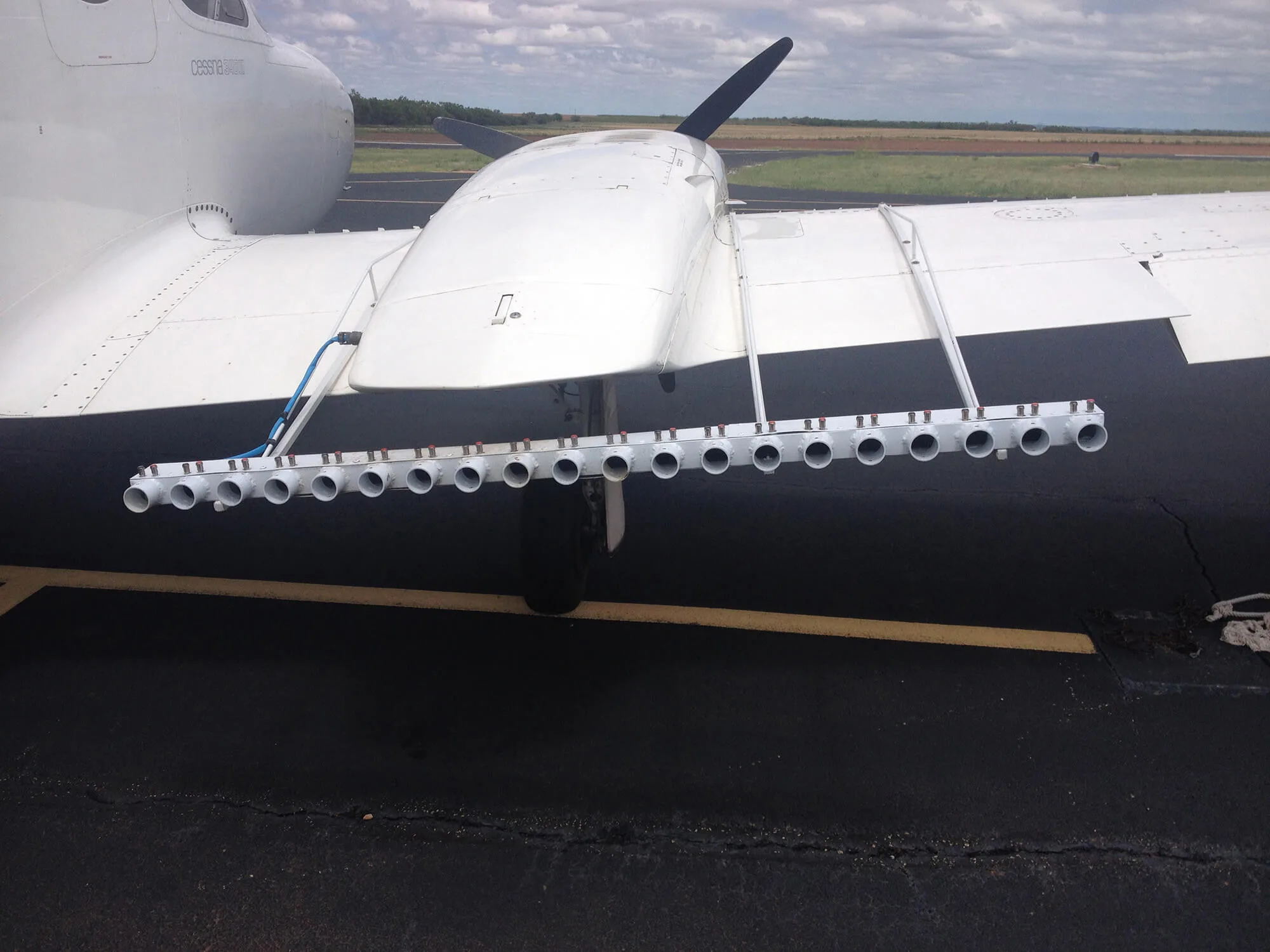
(Photo courtesy of Gary Walker/SOAR)
As of Nov. 16, Lake Mead sat at 1,044 feet above sea level, only 150 feet above the “dead zone.”
Arizona has been looking to a myriad of solutions to stem its worsening drought, including cloud seeding. The Salt River Project, which delivers water and electricity to central Arizona, has formed a partnership with the White Mountain Apache Tribe to research the feasibility of ground-based cloud seeding in the White Mountains in eastern Arizona.
So far, SRP is in the early stages of researching cloud seeding. For now, it’s only looking at a ground-based cloud seeding program to produce more snow in the White Mountains. The state also helps fund cloud seeding programs in Colorado meant to increase flows into the Colorado River.
Proponents say cloud seeding is the least expensive way to bring more precipitation to the Southwest, but they concede it wouldn’t be the whole answer to the region’s water woes.
The research comes at a crucial time. The megadrought that has gripped Arizona since 2000 has been the driest in more than 1,200 years, and it’s expected to persist in the near future, according to Nature Climate Change. On top of that, as of Nov. 16, Lake Mead sat at 1,044 feet above sea level, only 150 feet above the “dead zone” – the level where the reservoir doesn’t have enough water to produce electricity at Hoover Dam.
A study from ProPublica also highlights Arizona’s rapidly warming climate and depleting water supplies – which could make Arizona unable to sustain its population in the future.
How Cloud Seeding Works
Cloud seeding technology, which has been around for seven decades, gets clouds to drop more rain or snow than they would otherwise. It comprises a multitude of techniques, but the glaciogenic technique, which SRP is researching, sends silver iodide into a cloud to freeze the supercooled liquid suspended in the cloud.
Colorado has attempted to modify the weather since the 1950s.
“Silver iodide is what we burn in our (ice nucleus) generators, and it gets vaporized and floats up into the clouds,” said Andrew Rickert, manager of Colorado’s Weather Modification Program. “That molecule is pretty much exactly like a water molecule. It just encourages supercooled liquid water to have something to bind onto.”
He said water in these clouds is below freezing but too small to form into ice crystals and too light to fall to the ground. Silver iodide acts like an ice crystal and gives the supercooled liquid a platform to collect and form ice crystals.

“Ice is harder to form, but once it forms it grows faster than the water at the same humidity,” said Frank McDonough, associate research scientist of atmospheric science for the Desert Research Institute in Nevada. “That’s the tricky thing. Once the ice forms, the ice is like, ‘Sweet. I’m in a great place now to grow because I’m in a place full of water drops.’”
Once these ice crystals grow large enough, they fall as snow or rain.
White Mountain Apache Tribe’s Role
SRP partnered with the tribe to do initial research in the mountains of eastern Arizona, where the utility’s watersheds are located. The $140,000 research, which is wrapping up, has been mostly focused on computer models and weather patterns. The research was funded by SRP, the Arizona Department of Water Resources, and the cities of Phoenix and Tempe.
SRP’s water measurement lead, James Walter, said Arizona has a history of cloud seeding research but has never researched it in the White Mountains before.
“This is kind of the hole, a gap,” he said. “But yet geographically speaking, it looks like the most promising area” for cloud seeding.
Walter said the research indicates the White Mountains, unlike the rest of the Mogollon Rim, could be seeded with ground-based ice nucleus generators, which are far more cost efficient than aerial seeding, which requires an airplane carrying special flares.
Air Vs. Ground Cloud Seeding
There are two types of generators, a manual generator and a remote generator, Rickert said.
Remote generators are “state of the art generators that can be controlled completely by a (computer) tablet,” he said. They also put out more silver iodide solution and don’t have to be where someone can get to them.
“We can put these high up on ridge lines where you can’t get to in the winter unless you have a snowmobile,” Rickert said. “These higher areas are more conducive towards cloud seeding.”
Gary Walker, a pilot who started a Texas cloud seeding company called SOAR, said an air-based method – which Arizona may consider later – uses an airplane equipped with ejectable and burn-in-place flares.
Ejectable flares are dropped through the cloud base and used when the cloud ceilings are below safe flight levels.
“You fly into the top of the clouds – and I’m generally talking 18,000 to 20,000 feet – and penetrate the clouds and fire a flare out of the bottom of the plane,” Walker said. “It’s much like a shotgun shell. The cartridge itself stays on the airplane and only the flare that burns itself up comes out of the bottom.”
The flare, he said, will “tumble inside that cloud. Generally, there are enough updrafts that the flare will just sit there and tumble and burn up and dispense the silver iodide particles.”
Burn-in-place flares are used when the pilot can fly through clouds to directly disperse the silver iodide into the supercooled liquid.
Cost of a Cloud Seeding Program
In a study done by Wyoming, the state found that a ground-based seeding method with remote generators would cost $35 to $107 per acre foot of water produced (an acre-foot is about 326,000 gallons).
This cost was even lower in Texas. Across its seven cloud seeding projects, Texas produced 956,657 additional acre-feet of rainwater for $11 dollars per acre foot.
For now, Arizona is only considering a ground-based generator to seed the White Mountains during winter.
Walker said an air-based cloud seeding program for one plane in Texas and New Mexico costs about $50,000. A large portion of these costs depend on the cost of fuel for his airplane, the cost of living for the time he’s there to seed, and the number of flares he uses – 10 to 12 on average.
“The water we make with cloud seeding, even if you pay $50,000 a month, is pretty doggone cheap,” Walker said.
He stands behind cloud seeding because he has seen the effects of drought where he lives in the rolling plains of north Texas.
“Out of the Navy, I actually went to the panhandle and I was a cowboy for about 20 years,” Walker said. “Besides my family, my first love in life is the cattle business. ”
In the 1980s, he went to work for a water conservation company because of drought plaguing the panhandle and the declining levels of the Ogallala Aquifer.
“God gives us groundwater and rainwater and that’s all he gives us in that portion of Texas,” Walker said. “No surface water whatsoever.”
He said his time at the conservation company taught him that cloud seeding was a viable option for water augmentation because “you can’t make any more groundwater, but we know we can make a little more rainwater.” After serving in the Texas Legislature in the ’90s, he started SOAR.
The History of Cloud Seeding
Cloud seeding was invented in 1946 by American chemist and meteorologist Vincent Schaefer after he dropped 6 pounds of dry ice into a cloud and made it snow. Since then, cloud seeding has been used for purposes ranging from commercial use by ski resorts to military uses.
In the Vietnam War, the Pentagon started Operation Popeye, which used a silver-iodine-based cloud seeding method, to extend Vietnam’s monsoon season. Extra mud from rain made it difficult for the Viet Cong and North Vietnamese to use the roads to transport military equipment.
The operation, whose catchphrase was “Make mud, not war,” led to the U.N. Environmental Modification Convention – an international treaty that bans weather modification for hostile uses, which was ratified in 1976.
Since then, countries around the world have seeded clouds to create more precipitation or to suppress hail.
Colorado’s Cloud Seeding Program and Limitations
Arizona already is invested in cloud seeding. The Central Arizona Water Conservation District commits up to $470,000 annually to Colorado’s program. Snow created there melts and flows into the Colorado River for Arizona and six other states to use.
Rickert, with Colorado’s weather modification program, primarily does ground-based glaciogenic cloud seeding, which could offer Arizona researchers insights.
“All of the different characteristics of a storm need to be there for us to be able to seed,” he said. “If we have a storm coming through and the wind speeds aren’t right or the temperature isn’t right, we can’t seed.”
To succeed, Rickert said, his program needs storms to remain at 5 to 23 degrees Fahrenheit while staying below certain wind speeds. This means that his program can be unpredictable.
“To have a successful seeding program, it’s really dependent on the kind of winter we have,” Rickert said. He detailed how his program broke records last December, but January and February “were basically like nothing.”
McDonough, the DRI research scientist, also said cloud seeding is limited in its drought-curbing effects.
“Cloud seeding is not going to solve the drought for sure,” McDonough said. “Most of the studies we have done over the years have shown a well-run cloud seeding program can add maybe 10% more total precipitation over the course of a winter.”
Despite these limitations, he said, cloud seeding is a worthwhile endeavor.
“It is the only tool that can theoretically create more precipitation,” McDonough said. “There’s all these other ideas of, ‘Oh! We’ll pipe the Mississippi River over and these desalination plants along the coast.’ But that stuff is like 1,000 times more expensive than cloud seeding, and cloud seeding has been done for 60-plus years.”
The Environmental Impacts of Cloud Seeding
Opponents to cloud seeding contend silver iodide is dangerous because it’s considered toxic to aquatic life. Critics say the compound will accumulate in the environment over time. However, a number of studies, outlined here, have found cloud seeding has negligible impacts on the environment.
“All the silver iodide in the environment has been studied for 50 years and there are no impacts at all that are noticeable,” McDonough said. “It just leaves an inert dust particle on the ground.”
Silver iodide naturally occurring in the Earth’s crust is “a million times more” than the amount released during cloud seeding, he said, adding that silver iodide doesn’t interact with the environment.
“Usually, plants and roots use electrical charges to bring nutrients into the plant,” McDonough said. “And since silver iodide is uncharged it won’t become part of the plant’s biome. Therefore, it won’t become a part of the ecosystem.”
He also said you aren’t changing weather patterns or taking water away from other places when you cloud seed.
“Most of the moisture associated with the storm never even converts into a cloud, it just stays as vapor,” he said. “You’re not stealing precipitation. You are not robbing Peter to pay Paul.”
He added that researcher’s will research where runoff from cloud seeding will occur to stop flash flooding.
“It’s safe,” McDonough said. “I think it is a good tool. I think it should be used. It’s got minimal impact and it seems like it works pretty well.”
Looking for the latest Arizona news? Sign up for our FREE daily newsletter.

He said what? 10 things to know about RFK Jr.
The Kennedy family has long been considered “Democratic royalty.” But Robert F. Kennedy, Jr.—son of Robert F. Kennedy, who was assassinated while...

Here’s everything you need to know about this month’s Mercury retrograde
Does everything in your life feel a little more chaotic than usual? Or do you feel like misunderstandings are cropping up more frequently than they...

Arizona expects to be back at the center of election attacks. Its officials are going on offense
Republican Richer and Democrat Fontes are taking more aggressive steps than ever to rebuild trust with voters, knock down disinformation, and...

George Santos’ former treasurer running attack ads in Arizona with Dem-sounding PAC name
An unregistered, Republican-run political action committee from Texas with a deceptively Democratic name and ties to disgraced US Rep. George Santos...




